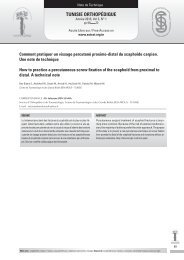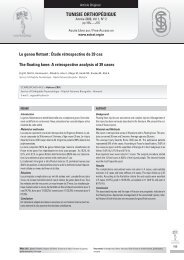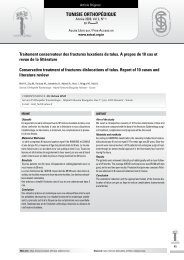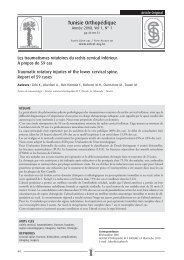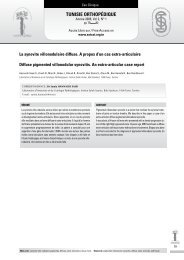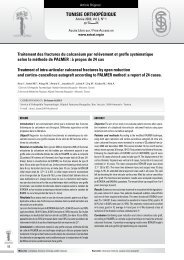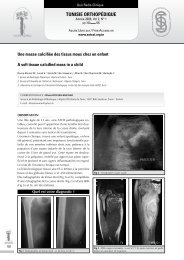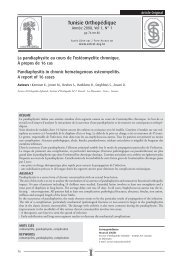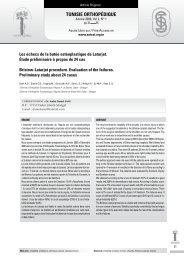Robert», la partie de l'art médical qui a pour objet - sotcot
Robert», la partie de l'art médical qui a pour objet - sotcot
Robert», la partie de l'art médical qui a pour objet - sotcot
You also want an ePaper? Increase the reach of your titles
YUMPU automatically turns print PDFs into web optimized ePapers that Google loves.
Tun Orthop 2008, Vol 1, N° 2204Guamgui A et al.dislocation of the radial head [6, 7]. Since then,this type of fracture-dislocation carries the nameof Monteggia and many reports of the injury havebeen published.In 1967, Bado [8] c<strong>la</strong>ssified Monteggia fracturedislocationin four types according to the type ofinjury to the ulna and location of the radial head.In type I, the anterior dislocation of the radial headis associated to a fracture of the ulnar diaphysis atany level with anterior angu<strong>la</strong>tion. In type II, thedislocation of the radial head is posterior or postero-<strong>la</strong>tera<strong>la</strong>nd the fracture of the ulna is in themiddle or the proximal third of the shaft. Type IIIassociates a fracture of the proximal ulnar metaphysisand a <strong>la</strong>teral dislocation of the radial head.The association between a fracture of the middleor proximal third of the ulnar shaft and an anteriordislocation of the radial head with a fracture ofthe middle third of the radial shaft constitute thetype IV of this c<strong>la</strong>ssification.The review of the literature shows that type I isthe most common in Monteggia injury with 60to 67%. However the type IV is the less commonand it accounts for 1 to 5% [6, 7, 9, 10].In our case the injury could be c<strong>la</strong>ssified as typeIV in Bado’s c<strong>la</strong>ssification with an atypical level ofthe radial fracture.Combination of Monteggia fracture dislocationand distal radial extremity injury is very rare inboth adults and children [8, 11, 12]. In adults, therare <strong>de</strong>scribed cases have been associated Monteggiaand Galeazzi injury [1, 2, 13, 14].In children and in our knowledge, only 3 caseshad been reported. The fracture concerned alwaysthe epiphyseal p<strong>la</strong>te. However, the distal radialfracture was metaphyseal in our case. It seems tobe the first <strong>de</strong>scribed case of an atypical Bado IVMonteggia injury in children.It is some times very difficult to <strong>de</strong>termine theexact mechanism of injury in a young child, whois usually unable to provi<strong>de</strong> precise <strong>de</strong>tails of theacci<strong>de</strong>nt. However, the position of the forearmwhen the patient is first seen, the position of thedistal end of the radius on the roentgenogramsand the direction of dislocation all provi<strong>de</strong> indirectclues about the mechanism of injury.The most common mechanism of injury for combinedfracture pattern in the forearm is due to fallwith the elbow in extension and the forearm inexcessive pronation [5].According to Evans, Monteggia fracture is a pronationlesion of the forearm. When a child falls ontohis outstretched hand the forearm is already inpronation, the hand becomes fixed on the groundand the forearm becomes an axe of rotation forthe rest of the body. When the normal <strong>de</strong>gree ofpronation is excee<strong>de</strong>d, the ulna first fractures. Thecontinuation of this external rotation leads to aradial head dislocation, then to a fracture in theupper third of the radial shaft.In our case, the fracture of the distal radial metaphysiscan be exp<strong>la</strong>ined by an important compressionforces applied on the wrist. These forcescause first the fracture of the lower radial extremityand the ad<strong>de</strong>d rotation of the trunk leads thento a Monteggia lesion.Because of the high inci<strong>de</strong>nce of missed injuriesand the severe consequences of a non diagnosedMonteggia lesion, the radiographs must alwaysinclu<strong>de</strong> the elbow and the wrist joints [15]. Dislocationof the distal radio-ulnar joint must besuspected and researched by the mean of clinicalexamination and centred radiographs of the wrist[3].In adults, open reduction and internal fixationof both fracture types was always done for thiscombined injury. However in children, open reductionhas been performed only in unsuccessfulclosed reduction. In our case, we obtainedan anatomical reduction of both fractures un<strong>de</strong>ranaesthesia.The key to good outcome in Monteggia fracturedislocationsis stable anatomical reduction of theulnar fracture and relocation of the radial head. Itis very important that residual angu<strong>la</strong>tion or shorteningof the ulna be avoi<strong>de</strong>d, as this could leadto persistent subluxation or dislocation of the radialhead.In most childhood cases, this can be achieved byclosed methods [16]. A good result is generallyobtained after 6 weeks of cast immobilisation.iV. reFerenCes1) C<strong>la</strong>re D.J., Corley F.G., Wirth M.A. Ipsi<strong>la</strong>teral combinationMonteggia and Galeazzi injuries in an adult patient:a case report. J Orthop Trauma 2000; 16:130-4.2) Maeda H., Yoshida K., Doi R., Omorio O. CombinedMonteggia and Galeazzi fractures in a child: a case reportand review of the literature. J Orthop Trauma 2003;17:128-31.3) Mann C., Jeer P., Hous<strong>de</strong>n P., Hy<strong>de</strong> I.D. Combined Galeazziand Monteggia forearm fracture. J R Soc Med2000; 93:144-5.4) Bjarne K., Eriksen A.F. Simultaneous type II Monteggialesion and fracture separation of the lower radial epiphysis.Injury 1986; 17:51-2.5) Shonnard P.Y., DeCoster T.A. Combined Monteggia andGaleazzi fractures in a child’s forearm. A case report.Orthop Rev 1994; 23:755-9.6) Ahmad M.A., White A., Reza S.A., Rai A., Patel A.D.When is a Monteggia fracture not a Monteggia fracture?Injury Extra 2007; 38:51-3.7) Bruce H.E., Harvey J.P., Wilson J.C. Monteggia Fractures.J Bone Joint Surg 1974; 56A:1563-76.8) Bado J.L. The Monteggia lesion. Clin Orthop 1967;50:71-86.9) Kamali M. Monteggia Fracture: presentation of an unu-



